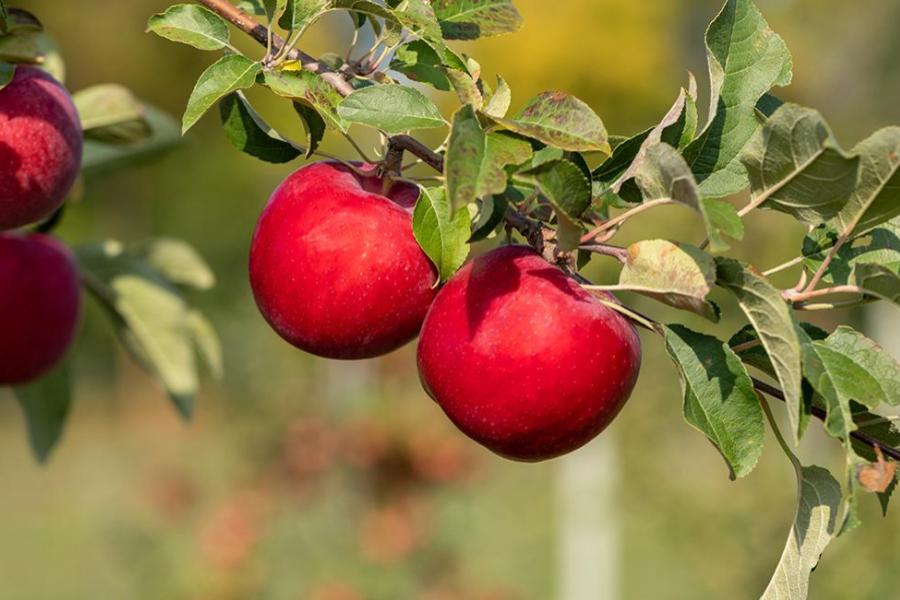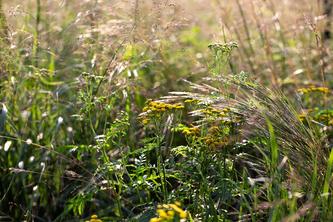
MINNEAPOLIS/ST. PAUL (09/27/2023) — If you enjoy a Honeycrisp, Haralson, SweeTango or First Kiss apple at your local orchard or farm stand this fall, you can thank the University of Minnesota apple breeding program for putting it there.
A new apple release from the U of M, called Kudos, might join your list of favorites in coming years!
David Bedford, a senior research fellow in the College of Food, Agricultural and Natural Resource Sciences, answers questions about the new apple.
Q: How would you describe Kudos?
Bedford: Kudos is a beautiful red apple with a unique combination of traits including an excellent crisp, juicy texture and a sweet, well-balanced flavor with occasional tropical overtones. It got those characteristics from its parents - Honeycrisp and Zestar!. The crisp, juicy texture is similar to Honeycrisp with the rich flavor of Zestar! but with a slight tropical twist.
Q: When can I try the new apple?
Bedford: Apples will not be widely available in the marketplace for a few years. Orchards have just begun to purchase and plant Kudos trees, so it will take a few years for those trees to mature and bear fruit. When we release an apple, it has already gone through roughly 20 years of evaluation to make sure it will perform well for growers and also be a pleasing eating experience for consumers. Since we’ve officially released it now, apple orchards can purchase Kudos trees with confidence that it will be able to provide their customers with great tasting apples in 2-4 years.
Q: What recent UMN apple releases can I taste this fall?
Bedford: Two of our more recent introductions are SweeTango and First Kiss/Rave.
SweeTango is also a cross between Honeycrisp and Zestar!. It has the crisp texture of Honeycrisp with an interesting sweet-tart flavor that is highly prized by apple lovers. It can be found at local orchards, farmers markets and grocery stores.
First Kiss is an early season progeny of Honeycrisp. It has a crisp and very juicy texture with a more tart, zingy flavor. Some people have compared the flavor to Haralson, an old favorite variety from the University breeding program’s early days. Fruit that is grown at orchards in Minnesota is marketed as First Kiss. When the trees are grown outside of Minnesota, the fruit is marketed as Rave. Because it is a newer variety and it ripens early in the season, it may become more difficult to find the fruit as the season progresses. First Kiss can be found at local orchards, farmers markets and grocery stores. Rave will only be found in grocery stores.
Q: Why did the University of Minnesota begin its apple breeding program and how does this work benefit Minnesotans?
Bedford: Many apples that you see at the grocery store, like Golden Delicious, Gala, Fuji and Granny Smith, won’t grow here. In fact, most of the apples grown worldwide won’t grow in Minnesota because they can't thrive in the harsh conditions of our extremely cold winters.
That’s why in the early 1900s, University of Minnesota researchers began developing cold hardy, great tasting apples in order to enjoy homegrown apples and bring a sustainable commercial apple industry to the state.
Q: How does apple breeding work at the U of M?
Bedford: We researchers identify parent apples with characteristics we’d like to combine into one apple. For example, one parent may be disease-resistant but not crisp and the other parent may be crisp but not disease-resistant. We cross the parents to try to develop a new variety that is both disease-resistant and crisp.
A few years after we make the crosses, the new trees bear fruit and we start our real evaluation. We taste the fruit of each tree - up to 500 apples each day - and decide if each one is worth keeping around or not. Very few of the thousands of apples that get tasted each growing season make it past the first round of tasting - typically only 10 to 12 each year. The best selections make it through even more testing and are released to the public. From initial cross to fruit on the supermarket shelf or at your farmers’ market takes 20 to 25 years.
You can learn more about the U of M apple breeding program at mnhardy.umn.edu or on the College of Food, Agricultural and Natural Resource Sciences website.
Kudos (MN33 variety), SweeTango (Minneiska variety), First Kiss/Rave (MN55 variety) and Zestar! (Minnewashta variety) are registered trademarks owned by the Regents of the University of Minnesota.
David Bedford is a senior research fellow in the College of Food, Agricultural and Natural Resource Sciences. His areas of interest include apple breeding, cultivar development and commercialization. His work is directed at the development of new apple cultivars through conventional breeding and the use of marker-assisted selection with special emphasis on the development of "explosively crisp" apples.
About the College of Food, Agricultural and Natural Resource Sciences
The University of Minnesota’s College of Food, Agricultural and Natural Resource Sciences (CFANS) strives to inspire minds, nourish people, and sustainably enhance the natural environment. CFANS has a legacy of innovation, bringing discoveries to life through science and educating the next generation of leaders. Every day, students, faculty, and researchers use science to address the grand challenges of the world today and in the future. CFANS offers an unparalleled expanse of experiential learning opportunities for students and the community, with 12 academic departments, 10 research and outreach centers across the state, the Minnesota Landscape Arboretum, the Bell Museum of Natural History, and dozens of interdisciplinary centers. Learn more at cfans.umn.edu.
About “Talking...with U of M”
“Talking...with U of M” is a resource whereby University of Minnesota faculty answer questions on current and other topics of general interest. Feel free to republish this content. If you would like to schedule an interview with the faculty member or have topics you’d like the University of Minnesota to explore for future “Talking...with U of M,” please contact University Public Relations at [email protected].
- Categories:
- Agriculture and Environment
- Horticultural





